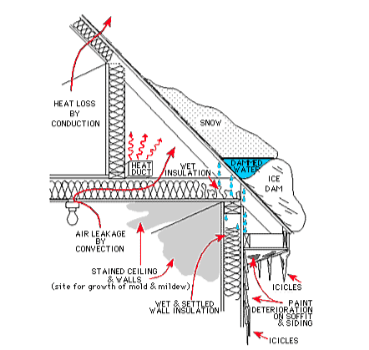In variable climates, like we have here in Wisconsin, preventing ice dams is just one of many challenges that can compromise your roof’s integrity. While a dwelling with poor insulation/ventilation is highly prone to ice damming during normal winter weather, even a home that has good ventilation and insulation can develop ice dams when there is extreme cold or heavy snow.
What is an Ice Dam?
An ice dam is a ridge of ice that forms at the edge of a roof and prevents melting snow from draining off the roof. The water that backs up behind the dam can leak into a home causing damage to walls, ceilings and insulation.
What Causes Ice Dams?
In a best-case scenario, melting snow flows down the roof, onto the eave and down through the gutter. Ice dams occur when snow accumulates on the roof, melts, and then refreezes. Because the eave and gutter are metal, they are naturally cooler and can cause the melted snow from above to refreeze in colder temperatures. Eventually, ice accumulates in the gutter and builds backward up the roof. Continued melting causes the size of this ice dam to build until the water accumulating behind it has nowhere to go but under the shingles and into your home.
Warm air rising up through the house and into the attic is a primary reason for snow on a roof to melt. This can be caused by:
- Inadequate insulation and/or ventilation.
- Lack of soffit vents, a situation often found in older homes.
- Insufficient roof venting.
- Insulation blockage of ventilation points between the soffit and attic.
- Air leaks and penetrations such as chimneys, plumbing and can lights.
Preventing Ice Dams
At L.H. Krueger and Son, we are committed to helping you protect your home from the outside-in. To help keep your interior walls, ceilings and furnishings safe from water damage due to ice damming:
- Make sure your attic is properly insulated.
- Seal entrances and scuttle holes into the attic.
- Provide proper ventilation to your attic through gable and eave vents.
- Ensure that vents are free of blockages and insulation.
- Keep gutters clean.
- In the event of heavy snowfall, keep the lower 3-5 feet of your roof snow-free.
- Install an adhesive backed waterproof membrane (Ice and Water Shield) under the shingles at the eaves and other critical areas.
- Install electric deicing cables in areas that have persistent problems BEFORE icing occurs.
L.H. Krueger and Son can do this for you!
What if Water is Leaking into My Home Right Now?
- Remove as much snow as possible with a roof rake (the bottom 3-5 feet is most important).
- Break ice dams by creating channels in the ice to drain water. Use caution to avoid roof and gutter damage.
- Contact a service that specializes in steaming the ice dams off. This can be very expensive.



